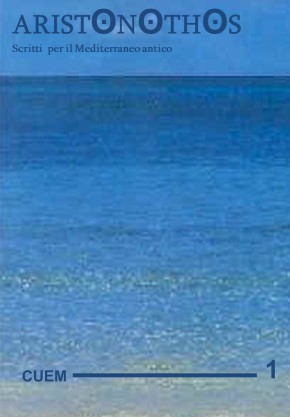Aristonothos. Il vaso
DOI:
https://doi.org/10.6092/2037-4488/570Abstract
The two scenes representing the blinding of the Cyclops Polyphemus by Odysseus and a naval battle, depicted on each side of the crater of Aristonothos (650 B.C.), found in a tomb of Cerveteri, are usually considered as two paratactic representations of the struggle between two different ethnic groups. This contribution presents a new hypothetical interpretation considering the crater as a visual and aesthetic unity: the two scenes might be read in sequence, one being the consequence of the other. Odysseus, skilled and gifted with intelligence (metis), faces the Cyclops; however his excessive metis upsets the Cyclops' father Poseidon and causes damage and struggle, expressed by the naval battle. At the same time the crab depicted under the handles of the crater, symbol of the right use of skill and intelligence, fits well in this frame.
The Aristonothos krater implies its usage in symposia where different ethnic groups could have been involved, shortly after the expansion of the Greeks westwards, in the frame of contacts among Greeks, Phoenicians and Etruscans. Thus the figured scene depicted on the crater might have acted as advice and warning regards the right use of wine.Dowloads
Pubblicato
Fascicolo
Sezione
Licenza
Gli Autori mantengono i diritti sulla loro opera e cedono alla Rivista il diritto di prima pubblicazione dell’opera, contemporaneamente licenziata sotto una Licenza Creative Commons - Attribuzione 4.0 Internazionale che permette ad altri di condividere l’opera indicando la paternità intellettuale e la prima pubblicazione su questa Rivista. Gli Autori concedono inoltre il diritto perpetuo di distribuirla gratuitamente al pubblico su qualsiasi supporto e in qualunque parte del mondo, ivi compresa la comunicazione al pubblico tramite il sito Web della Rivista.
Gli Autori possono aderire ad altri accordi di licenza non esclusiva per la distribuzione della versione dell'opera pubblicata (es. depositarla in un archivio istituzionale o pubblicarla in una monografia), a patto di indicare che la prima pubblicazione è avvenuta su questa Rivista.
Gli Autori mantengono il diritto di diffondere ad accesso aperto, tramite il proprio sito web o tramite un archivio istituzionale o disciplinare, l’opera dal momento della sua pubblicazione.
Gli Autori mantengono il diritto di creare opere derivate e di riprodurre, distribuire, eseguire o mostrare pubblicamente la propria opera in occasione di docenze, conferenze o presentazioni, o altre opere di natura scientifica e attività professionali esplicitando la sede di pubblicazione.
Gli Autori rinunciano, d’accordo con l’Editore, a qualunque eventuale forma di remunerazione accordata dalla normativa nazionale vigente ad autori ed editori per i diritti di reprografia a scopo non di lucro e prestito bibliotecario.





